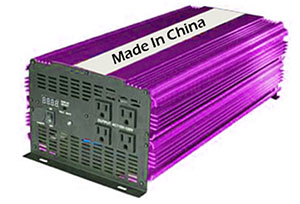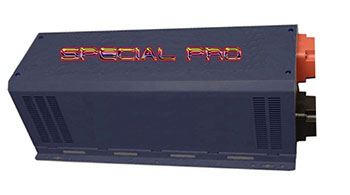Selecting The Best Off Grid Inverter For Your Home Or Business
After running a factory authorized inverter repair facility for nearly a decade and a half, we've seen just about every kind of failure you can imagine when it comes to inverters. The one thing we can tell you from experience is that the most critical component in your off grid solar system is not the solar panels or the mounting system, it's your inverter. Many consumers tend to focus most of their research and investment on high quality off grid solar panels but then opt to save a few dollars by selecting the cheapest Chinese designed and manfactured inverter available. Your off grid inverter is the workhorse of your system. While your off grid system can suffer several simultaneous solar panel failures and still operate, if your inverter fails, your system will cease to operate until the inverter is repaired or replaced.
Off grid inverters come in two very different waveform outputs (modified sine wave and pure sine wave) and two very different electrical designs (low frequency and high frequency). In this discussion, I will be focusing only on high frequency pure sine wave inverters versus low frequency pure sine wave inverters. The only thing you need to know about modified sine wave inverters is that for most modern applications, such as running a microwave, plasma, LED or LCD TVs, motors, stereo systems etc. NEVER use a modified sine wave (MSW) inverter unless you want to shorten the lives of these appliances.
The first off grid inverter design that I will talk about is the "high frequency" design which uses multiple parallel stages incorporating very small, lightweigt tranformers. The Chinese version of these high frequency off grid inverters are typically very complex, using many passive and active electronic components. The high component count of these off grid inverters makes them far more prone to failure and are the preferred design used by most Chinese off grid inverter manufacturers.
Because of the high component count, Chinese manufacturers tend to use the lowest cost, Chinese brand components that are available and manually solders these components onto the circuit board which increases the potential for cold solder joint failures. Back in the early 2000s we offered these Chinese desgned and built off grid inverters to our customers until the product return rate became intolerable. We still have several pallets worth of these failed inverters that we replaced as a courtesy to those customers because the Chinese manfacturers that we purchased them from went out of business long before the customer's warranties had expired. So needles to say, no more Chinese made off grid inverters for us or our customers.
Don't get me wrong though, there are a few American and German engineered off grid inverters that are on the market that use reputable, highly automated manufacturing facilities located in China that incorpoate high name brand quality components. But for the most part, If the inverter that you're considering looks like one of these in maybe a different shade of color, or weighs less than 40 lbs for a 2kW inverter or less than 60 lbs for a 5kW or greater inverter, or the inverter is not from a large multinational company, our advise is to stay away unless you enjoy throwing your money away replacing your off the grid inverter every couple of years.


These low cost (cheap) off grid inverters are fairly easy to spot. For one, they are very lightweight. While a high quality U.S. made 2kW inverter typically weighs in at 40 pounds or more, an equivalent 2 kW Chinese made inverter will only weigh 9 to 12 pounds. Another givaway for these light duty inverters is their metal casing. The Chinese inverter manufacturers like to use the external casing as a heat sink, so these inverters will typically have a ribbed ot finned look which helps to disipate the field effect transistor's heat.Some Chinese made off grid inverters will use a simple metal case with no heat sinks visible. The key identifying factor is the inverter's light weight.
Most U.S. and German engineered off grid inverters use a "low frequency" design that incorporates a single, very heavy, copper wound output transformer and far fewer discreet components resulting in a far more reliable design. Even a moderate sized 4kW, low frequency, off grid inverter can weigh as much as 120 lbs. Compare that to a Chinese made 4kW inverter that will typically weigh just 25 lbs and you soon realize that something is missing.
What's missing is the heavy duty, copper wound output tranformer. The use of a single, large transfomer not only enhances the inverter's reliability but typically also provides for a higher surge capacity than using multiple small transformers. Most U.S. and German engineered off grid inverters are manufactured using automated robotic techniques versus the manual assembly techniques used by many Chinese manufacturers. In addition these American and German designs use high quality name brand components and are warranted for a much longer period of time.
At Off Grid Solar, we only use the finest "low frequency" heavy duty off grid inverters in our systems assuring you of longer system life and higher performance.
Here's a funny video that was uploaded by a YouTuber depicting his frustration with his high frequency inverter.

